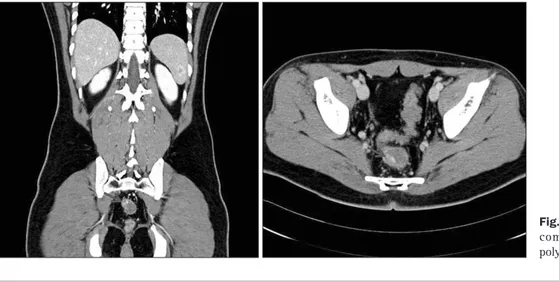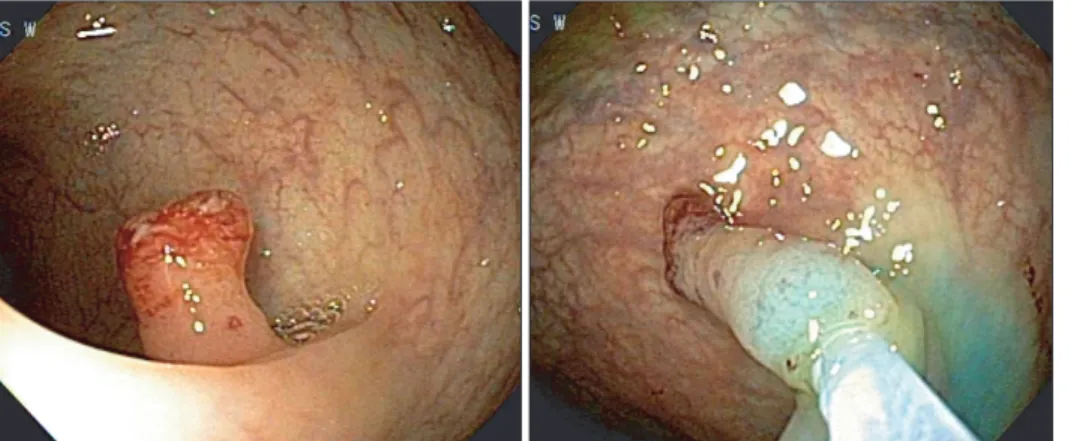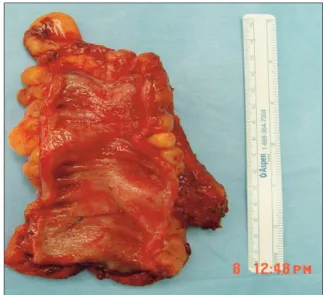Case report
Gut and Liver, Vol. 6, No. 1, January 2012, pp. 129-131
A Rare Case of a Signet Ring Cell Carcinoma of the Colon Mimicking a
Juvenile Polyp
Sun Hyung Kang*, Woo Suk Chung†, Chang Lim Hyun‡, Hee Seok Moon§, Eaum Seok Lee§, Seok Hyun Kim§, Jae Kyu
Sung§, Byung Seok Lee§, and Hyun Yong Jeong§
*Department of Internal Medicine, Armed Forces Daejeon Hospital, Daejeon, †Korea Advanced Institute of Science and Technology, Daejeon, ‡Department of
Pathology, Jeju National University Hospital, Jeju, and §Department of Internal Medicine, Chungnam National University Hospital, Daejeon, Korea
Primary signet ring cell carcinoma (SRC) of colon at early stage is quite rare. Only 26 cases were reported until now. We report an early stage of primary SRC which was misdi-agnosed as a juvenile polyp and treated with polypectomy followed by surgical resection. A 21-year-old male was ad-ministered for hematochezia. Abdominopelvic enhanced computed tomography revealed a polyp with active bleeding at the proximal rectum just below the rectosigmoid junction. Colonoscopy examination revealed a colon polyp with 0.5 cm sized head. Polypectomy was performed with snare and the polyp was completely removed. Biopsy revealed SRC. Surgi-cal resection was also performed and there were no residual tumor or lymph node metastasis in the surgical specimen. (Gut Liver 2012;6:129-131)
Key Words: Signet ring cell carcinoma; Early colon cancer; Juvenile polyp; Polypectomy
Correspondence to: Hee Seok Moon
Division of gastroenterology, Department of Internal Medicine, Chungnam National University Hospital, 640 Daesa-dong, Jung-gu, Daejeon 301-721, Korea
Tel: +82-42-280-8049, Fax: +82-42-257-5753, E-mail: mhs1357@cnuh.co.kr
Received on June 24, 2010. Revised on September 16, 2010. Accepted on September 28, 2010. pISSN 1976-2283 eISSN 2005-1212 http://dx.doi.org/10.5009/gnl.2012.6.1.129
This is an Open Access article distributed under the terms of the Creative Commons Attribution Non-Commercial License (http://creativecommons.org/licenses/by-nc/3.0) which permits unrestricted non-commercial use, distribution, and reproduction in any medium, provided the original work is properly cited.
INTRODUCTION
Signet ring cell carcinoma (SRC) in the colon is rare and oc-curs earlier in life than other types of adenocarcinoma. SRC is usually diagnosed at advanced stages and has a poor prog-nosis.1,2
The gross morphology of SRC is usually scirrhous or ulcerated.1 We report a case of early stage primary SRC that was
initially misdiagnosed as a juvenile polyp and treated with pol-ypectomy followed by surgical resection.
CASE REPORT
A 21-year-old male was admitted to our institution for treat-ment of hematochezia. The patient had no previous medical history. His vital signs were stable and his hemoglobin level was 13.9 mg/dL. Abdominopelvic enhanced computed tomography (CT) revealed a polyp with active bleeding at the proximal
rec-Fig. 1. Abdominopelvic enhanced computed tomography. A colon polyp with active bleeding is found.
130
Gut and Liver, Vol. 6, No. 1, January 2012tum just below the rectosigmoid junction (Fig. 1). Colonoscopy revealed a Yamada type IV colon polyp with a head 0.5 cm in size in the proximal rectum. The head showed erythematous changes and surface erosions, and we therefore assumed that this polyp was the bleeding point. The polyp was initially di-agnosed as a juvenile polyp after considering the patient’s age, the gross morphology of the polyp and the history of bleeding. After hypertonic saline epinephrine injection, a snare polypec-tomy was performed and the polyp was completely removed (Fig. 2). The diagnosis was corrected to SRC after biopsy (Fig. 3). The patient’s cancer was confined to the muscularis mucosa. Angiolymphatic invasion and tumor budding were not observed in the biopsy specimen. The longitudinal safety margin was 0.9 cm, and the lateral safety margin was 0.4 cm. We observed no dysplasia around the lesion. No additional lesions were found on positron emission tomography CT (PET CT) or esophago-gastroduodenoscopy. Surgical resection was performed due to the polyp’s poorly differentiated histopathology. There were no residual tumors or lymph node metastasis in the surgical speci-men (Fig. 4).
DISCUSSION
More than 96% of cases of SRC arise in the stomach, and the rest occur in the colon, rectum, gallbladder, pancreas, urinary bladder, and breast.3 In the present case, the primary lesion was
believed to be the rectum because no other organ involvement was detected by esophagogastroduodenoscopy, abdominal CT or PET CT. An additional surgical resection was performed due to a report indicating that lymph node metastasis often occurs in association with very small SRCs.4
The surgical specimen was free of lesions. In a previous study of 26 cases of early stage primary colon SRC2
with a mean age of 57.1 years (range, 6 to 69 years), six cases with mucosal cancer were documented, 16 with flat depressed lesions and 10 with polypoid lesions.2
SRC of the colon (including the advanced form) comprises about only 1% of all cases of colon cancer.2
When compared with other types of adenocarcinoma, patients with SRC in the colon are younger, more likely to experience lymph node metastasis and have a poorer prognosis.5 Colon cancer is rare in children
Fig. 3. The biopsy specimen reveals a signet ring cell carcinoma of the colon. Tumor cells are not found at the resection margin (H&E stain, ×20, ×100, ×200).
Fig. 2. A Yamada type IV colon polyp was found at the proximal rectum. After a hypertonic saline epinephrine injection, the polyp was completely removed using a snare.
Kang SH, et al: A Rare Case of a Signet Ring Cell Carcinoma of the Colon Mimicking a Juvenile Polyp
131
and adolescents, with only 159 cases (ages, 4 to 20 years) re-ported between January 1974 and December 2005 worldwide. Young colon cancer patients experienced poorer prognoses than adults, and 18% of juvenile colorectal cancer cases were SRC.6
Common endoscopic characteristics of juvenile polyps are erythematous changes and erosion of the head. Bleeding is also quite common in juvenile polyps, making them even more diffi-cult to diagnose. The practice of routine colonoscopy for health screening is increasing in South Korea, but in the absence of pain or bleeding, most physicians do not perform colonoscopies in younger patients, which results in late discovery of SRC, usu-ally in the advanced form.
There are two proposed pathways for the origin of SRC: a de novo pathway and origination from adenoma.7,8 In the present
case, few elongated glands were found in the head of the polyp, which laid under the signet ring cells. However, it is difficult to determine whether the lesion originated from a juvenile polyp due to the small number of elongated glands observed. We were unable to eliminate the possibility of malignant transforma-tion from a juvenile polyp. We hypothesized that, in our case, SRC originated by the de novo pathway because we observed
no dysplasia around the lesion. Due to the scarcity of reports regarding colon SRC, it is difficult to interpret the prognosis or natural history of this lesion. More case reports, accompanied by additional pathological and molecular biological studies, are required in order to establish an effective treatment strategy for primary SRC of the colon.
CONFLICTS OF INTEREST
No potential conflict of interest relevant to this article was reported.
REFERENCES
1. Makino T, Tsujinaka T, Mishima H, et al. Primary signet-ring cell carcinoma of the colon and rectum: report of eight cases and re-view of 154 Japanese cases. Hepatogastroenterology 2006;53:845-849.
2. Fu KI, Sano Y, Kato S, et al. Primary signet-ring cell carcinoma of the colon at early stage: a case report and a review of the litera-ture. World J Gastroenterol 2006;12:3446-3449.
3. Tung SY, Wu CS, Chen PC. Primary signet ring cell carcinoma of colorectum: an age- and sex-matched controlled study. Am J Gastroenterol 1996;91:2195-2199.
4. Urabe T, Kuroda Y, Urushihara T, Amano H, Yonehara S, Arihiro K. Two-mm diameter signet ring cell carcinoma of the rectum with lymph node metastasis: a report of case. Stomach Intest 1998;33:1179-83.
5. Nissan A, Guillem JG, Paty PB, Wong WD, Cohen AM. Signet-ring cell carcinoma of the colon and rectum: a matched control study. Dis Colon Rectum 1999;42:1176-1180.
6. Sultan I, Rodriguez-Galindo C, El-Taani H, et al. Distinct features of colorectal cancer in children and adolescents: a population-based study of 159 cases. Cancer 2010;116:758-765.
7. Tsujinaka Y, Tsuchiya S, Ooki S, et al. IIc type early carcinoma of the rectum originating “de novo”, report of a case. Stomach Intest 1983;18:211-217.
8. Nakamura T, Nakano G, Sakamoto K. Adenoma of the rectum with multiple foci of signet-ring cell carcinoma. Report of a case. Dis Colon Rectum 1983;26:529-532.
Fig. 4. Surgical specimen. There is no residual tumor or metastasis to the lymph nodes.


